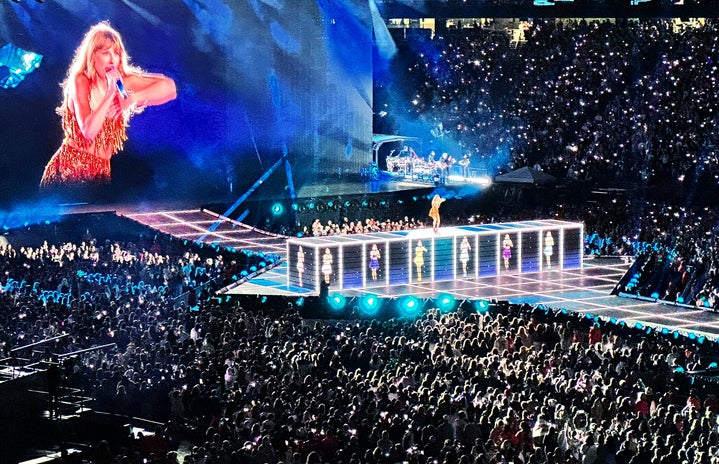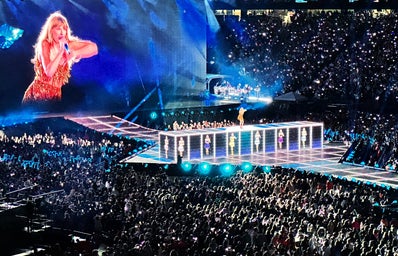The entertainment industry survives off fangirls since they basically rule the internet. The most talked about person and event right now is Taylor Swift and her Eras Tour. The mass popularity of it wouldn’t be what it is today without fangirls online sharing their support for an artist they like on platforms like X (formally Twitter), Instagram, and TikTok. The impacts are happening in real time, A Taylor Swift fan account on X even made Heinz create a new condiment just by tweeting that Swift was eating what looked to be “ketchup and seemingly ranch.” Even the Empire State Building lit up white and red in response to the fan’s post. So, if fangirls have such cultural significance to the entertainment industry, why do they receive so much hate?
Fangirls tend to show their love and support by dressing up for their favorite artists’ concerts, knowing fun facts and trivia, creating clubs to share their love, and purchasing merchandise. Are these actions any different to football fans painting their bodies for games, knowing players’ statistics off the top of their heads, participating in Fantasy Football with other fans, and purchasing their favorite players’ jerseys? Alicia Lansom at Refinery29 noted, “While I was laughed at for knowing my fave’s birthday and the words to all his songs, my guy friends could discuss every injury their favorite football player had ever had and be thought of as well-informed.” The author goes on to explain that this shows the blatant sexist sentiment: “When girls know a lot about something they love, they’re crazy; when boys do, they’re passionate.”
The word “crazy” has often been used to describe fangirls. That kind of negative description can create a damaging perception of groups of young girls who are excited over something they care about. After a documentary about One Direction fans was released on Channel 4 in 2013, young girls were labeled nothing but “crazy.” In Hannah Ewens’ book Fangirls: Scenes From Modern Music Culture, she states that “From the very beginning of the film emotions are pathologised.” Ewens suggested that before an audience watched it, there was an idea of how the young One Direction fans were going to be portrayed; “Any ounce of feeling an audience sees from the moment it decides to watch something called Crazy About One Direction is framed as unhinged, even if a girl screaming about tickets or trying to meet her idol is understandable.” Ewens interviewed many fans who were included in the documentary and found that the producers only used the worst parts, and that the documentary made the young fans seem not only obsessive but dangerous to the artists. The author also interviewed fans who were edited out of the documentary and when asked why they thought they didn’t make the final cut, one girl stated, “we just weren’t crazy enough.”
Refinery29 states that in the book Believability: Sexual Violence, Media, and the Politics of Doubt, co-author Professor Sarah Banet-Weiser describes the “crazy,” “obsessive,” and “dangerous” characterization of fangirls as an unfair depiction that is often present in the scrutiny of women in general. Banet-Weiser told Refinery29, “As far as I know, most of the cases of fans stalking and being violent against celebrities are men,” as stalkers are more often cis men than women. Banet-Weiser explains how “The idea that women fans are unstable is a real issue as it connects to women being seen as irrational.”
The media deems it acceptable to mock fangirls about their excitement and love for things, but that doesn’t mean they don’t get appreciation from the artists that they help make successful. A 2017 Rolling Stone article featured Harry Styles being asked what he thinks about seeking credibility beyond the young girls that make up his audience demographic. Refinery29 points out that these are the same young girls who made Styles’ latest tour the “10th highest-grossing tour of all time.” Styles replied, “Who’s to say that young girls who like pop music – short for popular, right? – have worse musical taste than a 30-year-old hipster guy…Young girls like the Beatles.” He defends the seriousness of his female fanbase by stating, “You gonna tell me they’re not serious? How can you say young girls don’t get it? They’re our future.” Styles’ defense shows how important fangirls are to the success of the entertainment world and how they are taken less seriously for their pop music taste.
Some might argue that there is a darker, more obsessive love that some fangirls have for artists. Public figures, like Taylor Swift, have had their houses broken into or have had their vehicles tailed. After multiple instances of trespassing and stalking with different “fans”, Taylor Swift spoke out about the safety issue saying, “you get enough stalkers trying to break into your house and you kind of start prepping for bad things.” Many die-hard fans disagree about how far they should go to see their favorite artists. While some may go as far as tracking down a restaurant to get a glimpse at their favorite star, other fans think that this is crossing a line when it comes to privacy. In August, a photo of Taylor Swift in New Jersey at Jack Antonoff and Margaret Qualley’s wedding rehearsal dinner spread online and within hours, hundreds of people were waiting outside the venue for a chance to take photos of Swift. The reaction was varied with one fan on TikTok calling out those people saying, “THOSE. ARENT. FANS. Taylor hates when this happens, just watch Miss Americana. This is creepy behavior.” Another person posted that this was another example of the parasocial relationships that fans have with artists, saying “Smh…fan culture is creepy. Imagine being obsessed with someone who has no idea you exist.” Whether the people that gathered outside the venue were real fans or onlookers trying to see a famous person, there are levels to how fans or fangirls show their love, and some ways can be toxic and scary.
The scrutiny and jokes made about fangirls creates a damaging perception surrounding girls of all ages. Actions done out of excitement, love, and support should be seen as no different than a football fan who travels to see their favorite team play and follows their wins and losses. In my opinion, some fan reactions and behaviors can be toxic, but that doesn’t represent the whole fangirl community; and to characterize fangirls as “crazy” and male fans as “passionate” conveys that there are obvious double standards. The hate that fangirls receive highlights only one aspect of the biased and sexist undertones that are present within society today. Artists are known to show support for their fans and thank them for their excitement towards events and releases, so society should show appreciation for fangirls as the entertainment industry wouldn’t be what it is without them.


